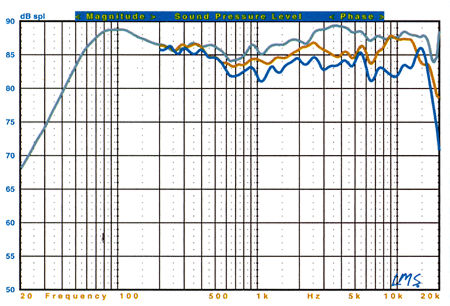Paradigm Signature surround speaker system Measurements
The Paradigm Signatures were measured with their grilles removed. For both speakers (S4 and C3), the grilles slightly reduced the treble level but also made the high-frequency response rougher.
The Signature S4's sensitivity measured approximately 87dB/2.83V/m. Its ported cabinet is tuned to about 32Hz, and its minimum impedance is 4.4ohm at 930Hz; I would rate its nominal impedance at 6ohm. While its impedance is quite capacitive at 78Hz (with a phase angle of –73°), the S4's impedance magnitude at this frequency is 11.2ohm. I would rate the S4 as moderately difficult to drive, though it should cause no difficulties for a competent amplifier of the sort likely to be used with such a high-end speaker.
The S4's pseudoanechoic response at tweeter height, averaged over a 30° forward horizontal angle and combined with the nearfield responses of the woofer and port, is shown in Fig. 1 (violet). The useful bass extends down to about 38Hz (–10dB relative to the output at 100Hz). The on-axis average shows a distinctly elevated response from about 2.4kHz to just over 15kHz. The response in this region is relatively smooth, however; the ear may read it as a recessed response in the midrange, centered around 700Hz, rather than a bright top. The off-axis response is flatter; combined, the on- and off-axis responses may result in a slightly flatter in-room top end than the on-axis response shown here suggests.

Fig. 1: Paradigm Signature S4, pseudoanechoic horizontal response at 45° (red) and 60° (blue) relative to tweeter axis.
Fig. 2 again shows the S4's averaged horizontal front response (violet), plus the vertical responses taken at +15° (red) and –15° (blue) relative to the tweeter. You should audition this speaker with your ears as close as possible to the height of the tweeter height.

Fig. 2: Paradigm Signature S4, pseudoanechoic vertical response at +15° (red) and –15° (blue) relative to tweeter axis.
The C3 center-channel's cabinet is tuned to about 75Hz. I would rate its nominal impedance at 5ohm; the minimum impedance was 3.3ohm at 98Hz. The speaker's sensitivity measured about 87dB/2.83V/m. It is also moderately capacitive at 70Hz, and its impedance characteristics should make it, overall, of average difficulty to drive.
The C3's measured front horizontal response, taken on the tweeter axis and averaged in the same manner as described above for the S4, is shown in Fig. 3 (violet). The useful bass extension is approximately 46Hz (–10dB relative to the output at 90Hz). The on-axis response is fairly similar to the S4's: the same rising top end, the same flatter response off-axis. Notably, this 3-way design shows none of the off-axis suckout through the midrange of the sort that afflicts all other 2-way, horizontally configured center-channel speakers we have measured.

Fig. 3: Paradigm e Signature C3, pseudoanechoic horizontal response at 45° (red) and 60° (blue) to left of tweeter axis.
The vertical off-axis response of the C3 (Fig. 4) indicates that you should listen to this speaker with your ears positioned at or just below the tweeter height.

Fig. 4: Paradigm Signature C3, pseudoanechoic vertical response at +15° (red) and –15° (blue) relative to tweeter axis.
The only significant aberration in these measurements is the relatively high tweeter output from both speakers. The curves suggest that they may sound forward in the upper registers. FM did note this in his listening tests. The relatively smooth HF response (apart from the overall elevated level) suggests that it might be corrected by simply padding down the tweeter by 2–3dB, or using a judicious hand on a treble control, without obscuring the impressive sound that Fred reports.—Thomas J. Norton
All figures: Violet: pseudoanechoic response on tweeter axis, averaged across a 30 horizontal window, combined with nearfield responses of woofers and port.
- Log in or register to post comments




































































